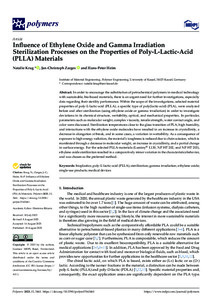Influence of Ethylene Oxide and Gamma Irradiation Sterilization Processes on the Properties of Poly-L-Lactic-Acid (PLLA) Materials
| dc.date.accessioned | 2023-10-06T10:52:13Z | |
| dc.date.available | 2023-10-06T10:52:13Z | |
| dc.date.issued | 2023-08-18 | |
| dc.identifier | doi:10.17170/kobra-202310058826 | |
| dc.identifier.uri | http://hdl.handle.net/123456789/15102 | |
| dc.description.sponsorship | Gefördert durch den Publikationsfonds der Universität Kassel | |
| dc.language.iso | eng | |
| dc.rights | Namensnennung 4.0 International | * |
| dc.rights.uri | http://creativecommons.org/licenses/by/4.0/ | * |
| dc.subject | bioplastics | eng |
| dc.subject | poly-L-lactic-acid (PLLA) | eng |
| dc.subject | sterilization | eng |
| dc.subject | gamma irradiation | eng |
| dc.subject | ethylene oxide | eng |
| dc.subject | single-use products | eng |
| dc.subject | medical devices | eng |
| dc.subject.ddc | 530 | |
| dc.subject.ddc | 540 | |
| dc.title | Influence of Ethylene Oxide and Gamma Irradiation Sterilization Processes on the Properties of Poly-L-Lactic-Acid (PLLA) Materials | eng |
| dc.type | Aufsatz | |
| dcterms.abstract | In order to encourage the substitution of petrochemical polymers in medical technology with sustainable, bio-based materials, there is an urgent need for further investigations, especially data regarding their sterility performance. Within the scope of the investigations, selected material properties of poly-L-lactic-acid (PLLA), a specific type of poly(lactic-acid) (PLA), were analyzed before and after sterilization (using ethylene oxide or gamma irradiation) in order to investigate deviations in its chemical structure, wettability, optical, and mechanical properties. In particular, parameters such as molecular weight, complex viscosity, tensile strength, water contact angle, and color were discussed. Sterilization temperatures close to the glass transition of PLA, high humidity, and interactions with the ethylene oxide molecules have resulted in an increase in crystallinity, a decrease in elongation at break, and in some cases, a variation in wettability. As a consequence of exposure to high-energy radiation, the material’s toughness is reduced due to chain scission, which is manifested through a decrease in molecular weight, an increase in crystallinity, and a partial change in surface energy. For the selected PLLA-materials (Luminy® L130, NP HT 202, and NP HT 203), ethylene oxide sterilization resulted in a comparatively minor variation in the characteristics behavior, and was chosen as the preferred method. | eng |
| dcterms.accessRights | open access | |
| dcterms.creator | Krug, Natalie | |
| dcterms.creator | Zarges, Jan-Christoph | |
| dcterms.creator | Heim, Hans-Peter | |
| dc.relation.doi | doi:10.3390/polym15163461 | |
| dc.relation.issupplementedby | doi:10.48662/daks-35 | |
| dc.subject.swd | Medizinisches Gerät | ger |
| dc.subject.swd | Biopolymere | ger |
| dc.subject.swd | Ethylenoxid | ger |
| dc.subject.swd | Gammabestrahlung | ger |
| dc.type.version | publishedVersion | |
| dcterms.source.identifier | eissn:2073-4360 | |
| dcterms.source.issue | Issue 16 | |
| dcterms.source.journal | Polymers | eng |
| dcterms.source.volume | Volume 15 | |
| kup.iskup | false | |
| dcterms.source.articlenumber | 3461 |
Dateien zu dieser Ressource
Das Dokument erscheint in:
-
Artikel [1186]


